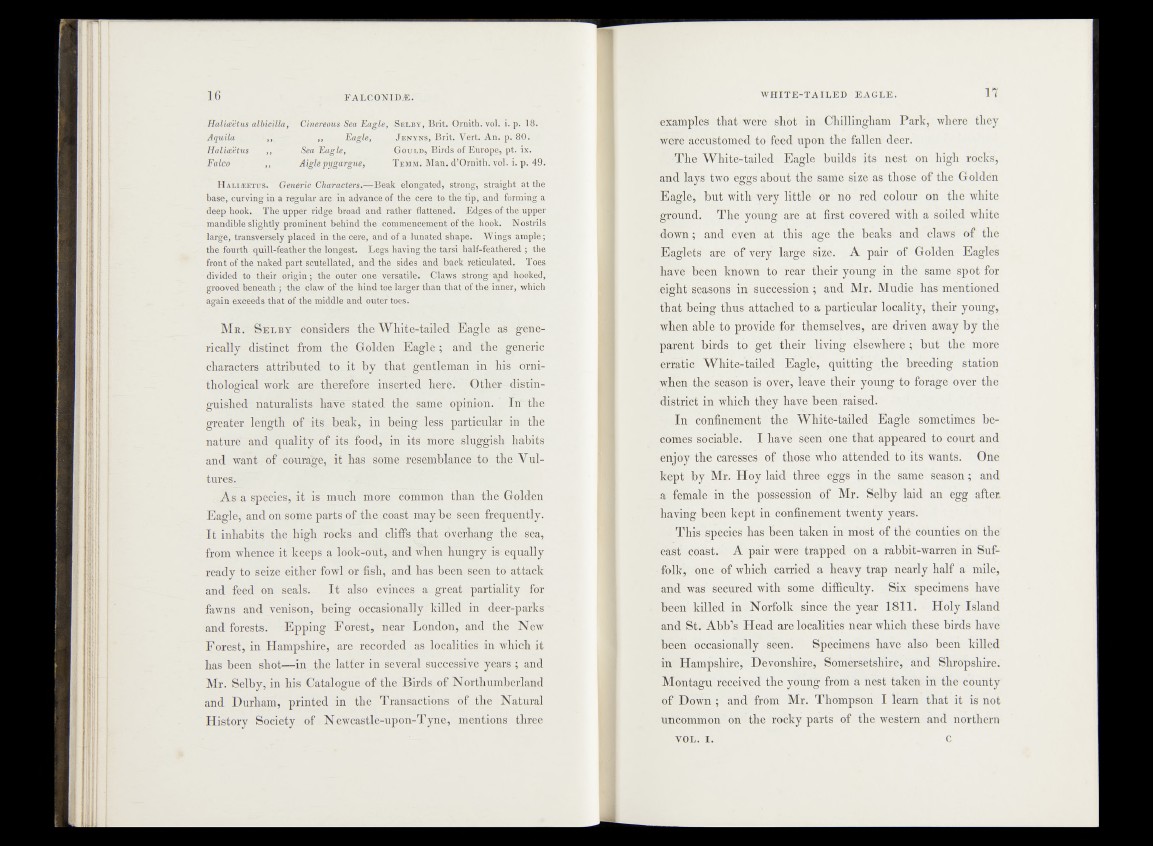
Haliceetus albicilla, Cinereous Sea Eagle, S elby, Brit. Ornith. vol. i. p. 18.
Aquila ,, ,, Eagle, J enyns, Brit. Vert. An. p. 80.
Halimetus ,, Sea Eagle, G ould, Birds of Europe, pt. ix.
Falco ,, Aiglepygargue, T ehm. Man. d’Ornith. vol. i. p. 49.
Hali/eetus. Generic Characters.— Beak elongated, strong, straight at the
base, curving in a regular arc in advance of the cere to the tip, and forming a
deep hook. The upper ridge broad and rather flattened. Edges of the upper
mandible slightly prominent behind the commencement of the hook. Nostrils
large, transversely placed in the cere, and of a lunated shape. Wings ample;
the fourth quill-feather the longest. Legs having the tarsi half-feathered ; the
front of the naked part scutellated, and the sides and back reticulated. Toes
divided to their origin; the outer one versatile. Claws strong and hooked,
grooved beneath ; the claw of the hind toe larger than that of the inner, which
again exceeds that of the middle and outer toes.
M e . S e l b y considers the White-tailed Eagle as gene-
rically distinct from the Golden Eagle; and the generic
characters attributed to it by that gentleman in his ornithological
work are therefore inserted here. Other distinguished
naturalists have stated the same opinion. In the
greater length of its beak, in being less particular in the
nature and quality of its food, in its more sluggish habits
and want of courage, it has some resemblance to the Vultures.
As a species, it is much more common than the Golden
Eagle, and on some parts of the coast maybe seen frequently.
I t inhabits the high rocks and cliffs that overhang the sea,
from whence it keeps a look-out, and when hungry is equally
ready to seize either fowl or fish, and has been seen to attack
and feed on seals. I t also evinces a great partiality for
fawns and venison, being occasionally killed in deer-parks
and forests. Epping Forest, near London, and the New
Forest, in Hampshire, are recorded as localities in which it
has been shot—in the latter in several successive years ; and
Mr. Selby, in his Catalogue of the Birds of Northumberland
and Durham, printed in the Transactions of the Natural
History Society of Newcastle-upon-Tyne, mentions three
examples that were shot in Chillingham Park, where they
were accustomed to feed upon the fallen deer.
The White-tailed Eagle builds its nest on high rocks,
and lays two eggs about the same size as those of the Golden
Eagle, but with very little or no red colour on the white
ground. The young are at first covered with a soiled white
down; and even at this age the beaks and claws of the
Eaglets are of very large size. A pair of Golden Eagles
have been known to rear their young in the same spot for
eight seasons in succession ; and Mr. Mudie has mentioned
that being thus attached to a particular locality, their young,
when able to provide for themselves, are driven away by the
parent birds to get their living elsewhere ; but the more
erratic White-tailed Eagle, quitting the breeding station
when the season is over, leave their young to forage over the
district in which they have been raised.
In confinement the White-tailed Eagle sometimes becomes
sociable. I have seen one that appeared to court and
enjoy the caresses of those who attended to its wants. One
kept by Mr. Hoy laid three eggs in the same season; and
a female in the possession of Mr. Selby laid an egg after,
having been kept in confinement twenty years.
This species has been taken in most of thé counties on the
east coast. A pair were trapped on a rabbit-warren in Suffolk,
one of which carried a heavy trap nearly half a mile,
and was secured with some difficulty. Six specimens have
been killed in Norfolk since the year 1811. Holy Island
and St. Abb’s Head are localities near which these birds have
been occasionally seen. Specimens have also been killed
in Hampshire, Devonshire, Somersetshire, and Shropshire.
Montagu received the young from a nest taken in the county
of Down ; and from Mr. Thompson I learn that it is not
uncommon on the rocky parts of the western and northern